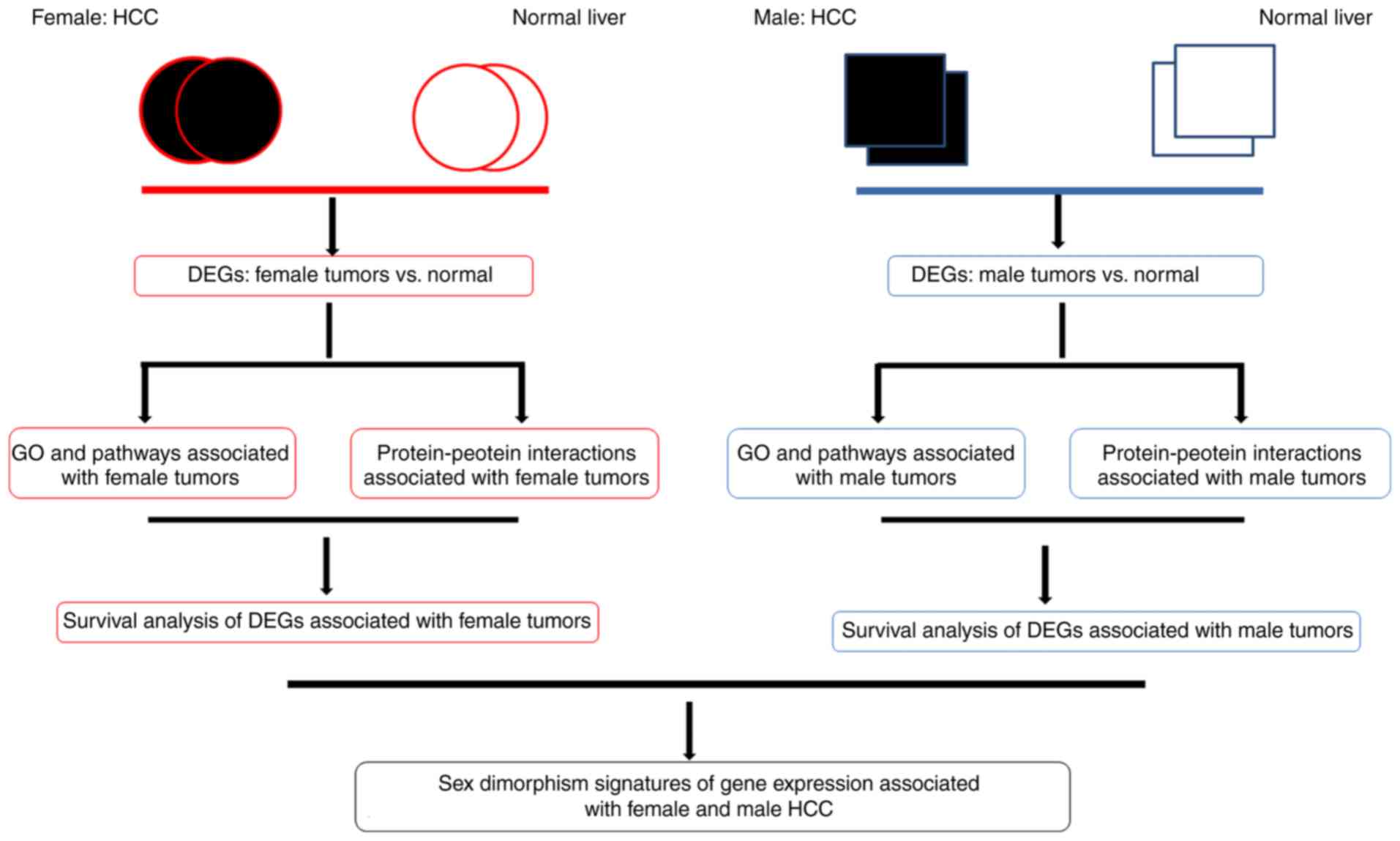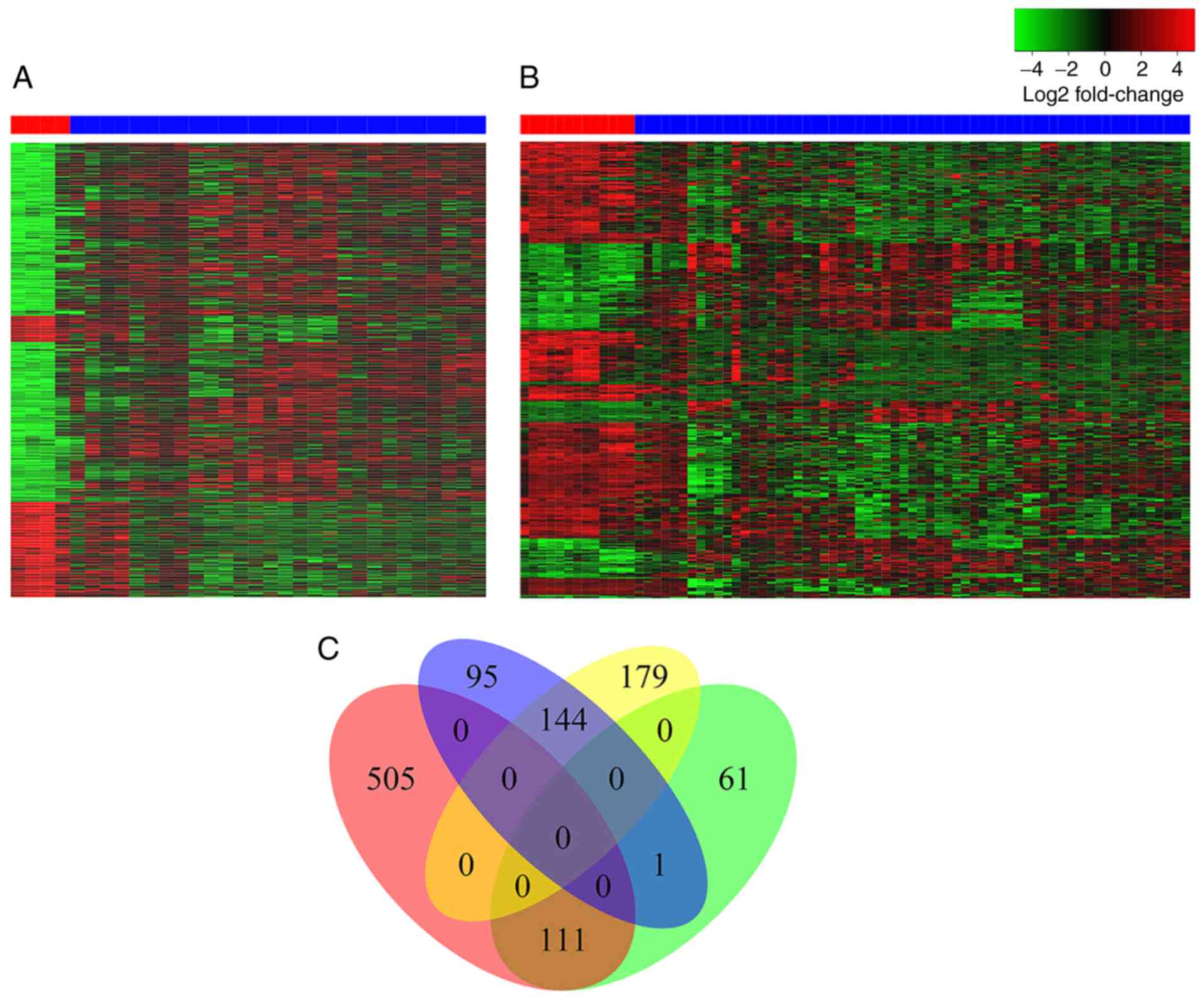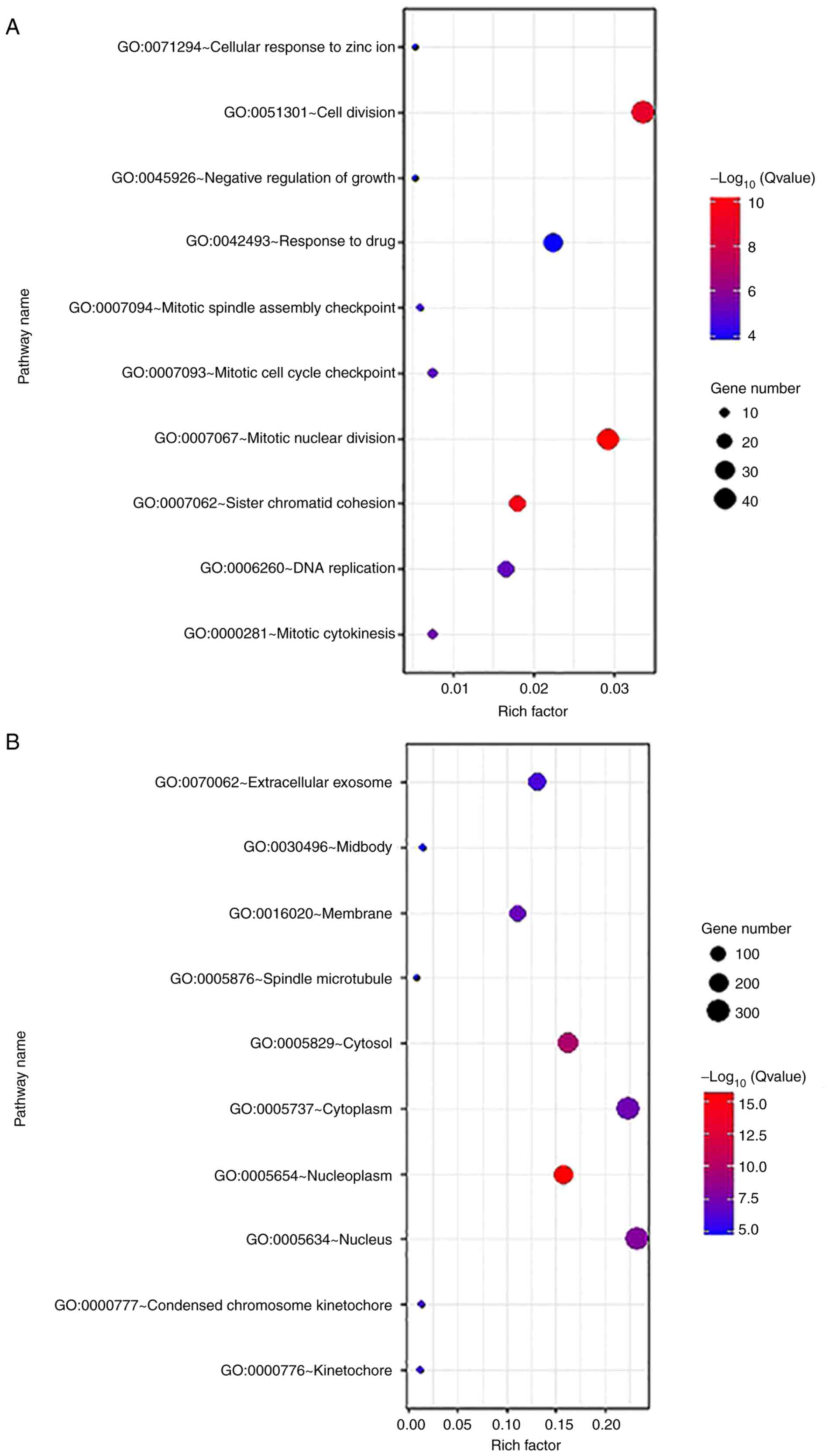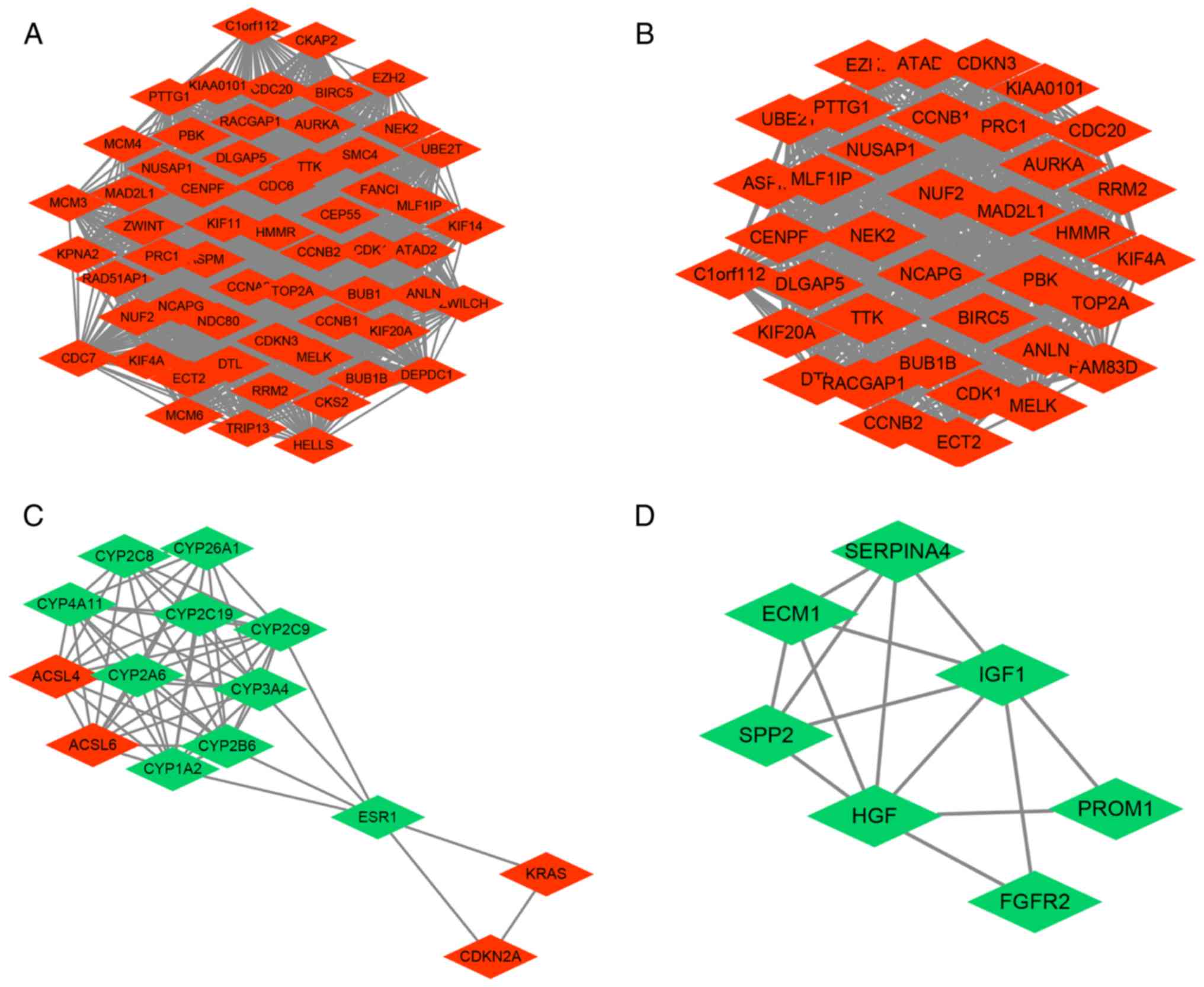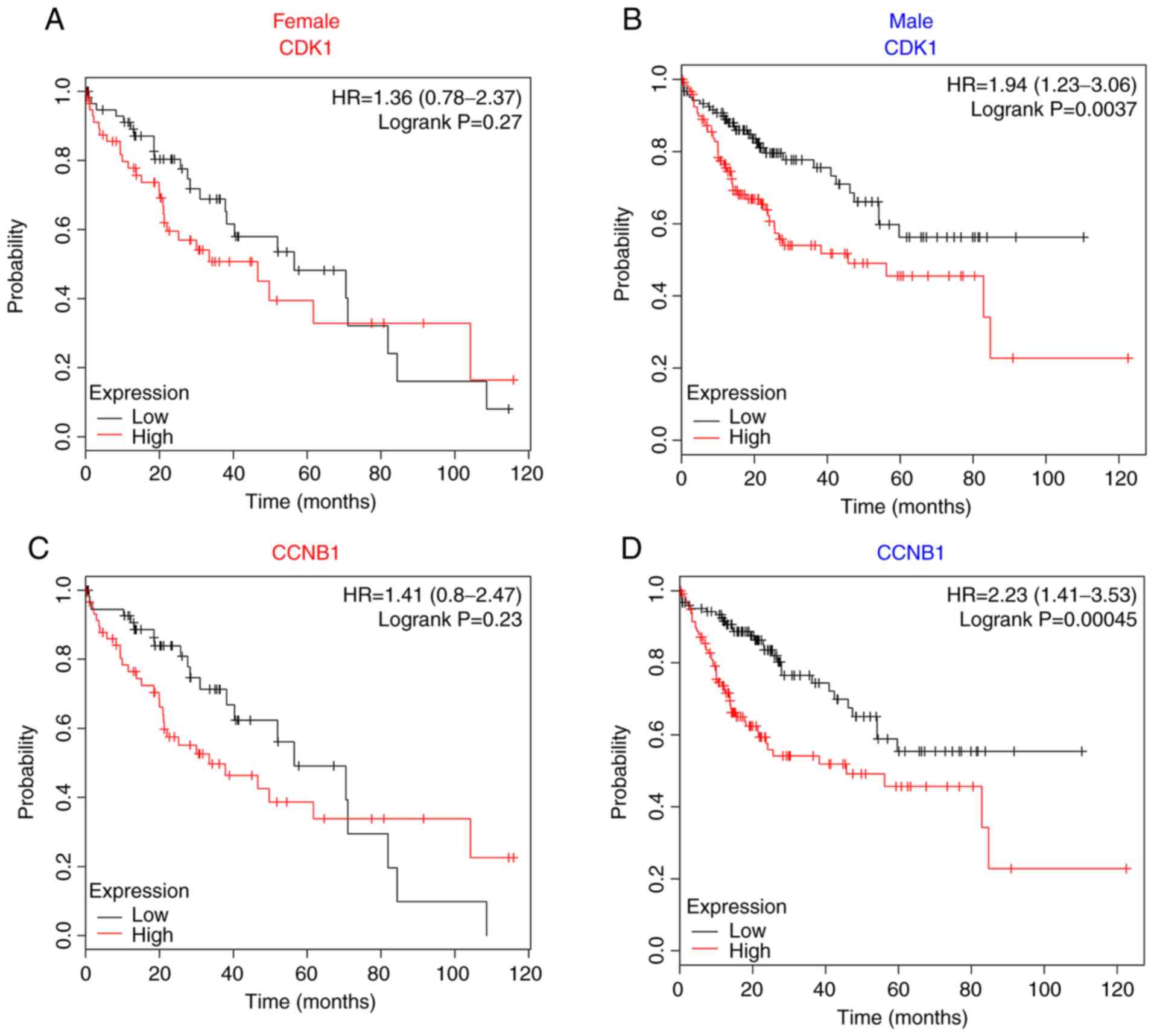|
1
|
Lagranha CJ, Silva TLA, Silva SCA, Braz
GRF, da Silva AI, Fernandes MP and Sellitti DF: Protective effects
of estrogen against cardiovascular disease mediated via oxidative
stress in the brain. Life Sci. 192:190–198. 2018. View Article : Google Scholar : PubMed/NCBI
|
|
2
|
Li R, Cui J and Shen Y: Brain sex matters:
Estrogen in cognition and Alzheimer's disease. Mol Cell Endocrinol.
389:13–21. 2014. View Article : Google Scholar : PubMed/NCBI
|
|
3
|
Torre LA, Bray F, Siegel RL, Ferlay J,
Lortet-Tieulent J and Jemal A: Global cancer statistics, 2012. CA
Cancer J Clin. 65:87–108. 2015. View Article : Google Scholar : PubMed/NCBI
|
|
4
|
Dorak MT and Karpuzoglu E: Gender
differences in cancer susceptibility: An inadequately addressed
issue. Front Genet. 3:2682012. View Article : Google Scholar : PubMed/NCBI
|
|
5
|
Institute of Medicine (US) Committee on
Understanding the Biology of Sex and Gender Differences, .
Exploring the Biological Contributions to Human Health: Does Sex
Matter? Wizemann TM and Pardue ML: National Academies Press (US);
Washington, DC: 2001,
|
|
6
|
Li Z, Tuteja G, Schug J and Kaestner KH:
Foxa1 and Foxa2 are essential for sexual dimorphism in liver
cancer. Cell. 148:72–83. 2012. View Article : Google Scholar : PubMed/NCBI
|
|
7
|
Molife R, Lorigan P and MacNeil S: Gender
and survival in malignant tumours. Cancer Treat Rev. 27:201–209.
2001. View Article : Google Scholar : PubMed/NCBI
|
|
8
|
El-Serag HB: Epidemiology of viral
hepatitis and hepatocellular carcinoma. Gastroenterology.
142:1264–1273.e1. 2012. View Article : Google Scholar : PubMed/NCBI
|
|
9
|
Ruggieri A, Barbati C and Malorni W:
Cellular and molecular mechanisms involved in hepatocellular
carcinoma gender disparity. Int J Cancer. 127:499–504. 2010.
View Article : Google Scholar : PubMed/NCBI
|
|
10
|
Yuan Y, Liu L, Chen H, Wang Y, Xu Y, Mao
H, Li J, Mills GB, Shu Y, Li L and Liang H: Comprehensive
characterization of molecular differences in cancer between male
and female patients. Cancer Cell. 29:711–722. 2016. View Article : Google Scholar : PubMed/NCBI
|
|
11
|
Villa E, Baldini GM, Pasquinelli C,
Melegari M, Cariani E, Di Chirico G and Manenti F: Risk factors for
hepatocellular carcinoma in Italy. Male sex, hepatitis B virus,
non-A non-B infection, and alcohol. Cancer. 62:611–615. 1988.
View Article : Google Scholar : PubMed/NCBI
|
|
12
|
Lee CM, Lu SN, Changchien CS, Yeh CT, Hsu
TT, Tang JH, Wang JH, Lin DY, Chen CL and Chen WJ: Age, gender, and
local geographic variations of viral etiology of hepatocellular
carcinoma in a hyperendemic area for hepatitis B virus infection.
Cancer. 86:1143–1150. 1999. View Article : Google Scholar : PubMed/NCBI
|
|
13
|
El-Serag HB: Hepatocellular carcinoma and
hepatitis C in the United States. Hepatology 36 (5 Suppl 1).
S74–S83. 2002.
|
|
14
|
Iyer JK, Kalra M, Kaul A, Payton ME and
Kaul R: Estrogen receptor expression in chronic hepatitis C and
hepatocellular carcinoma pathogenesis. World J Gastroenterol.
23:6802–6816. 2017. View Article : Google Scholar : PubMed/NCBI
|
|
15
|
Hassan MM, Botrus G, Abdel-Wahab R, Wolff
RA, Li D, Tweardy D, Phan AT, Hawk E, Javle M, Lee JS, et al:
Estrogen replacement reduces risk and increases survival times of
women with hepatocellular carcinoma. Clin Gastroenterol Hepatol.
15:1791–1799. 2017. View Article : Google Scholar : PubMed/NCBI
|
|
16
|
Naugler WE, Sakurai T, Kim S, Maeda S, Kim
K, Elsharkawy AM and Karin M: Gender disparity in liver cancer due
to sex differences in MyD88-dependent IL-6 production. Science.
317:121–124. 2007. View Article : Google Scholar : PubMed/NCBI
|
|
17
|
Zhao Y and Li Z: Interplay of estrogen
receptors and FOXA factors in the liver cancer. Mol Cell
Endocrinol. 418:334–339. 2015. View Article : Google Scholar : PubMed/NCBI
|
|
18
|
Zheng B, Zhu YJ, Wang HY and Chen L:
Gender disparity in hepatocellular carcinoma (HCC): Multiple
underlying mechanisms. Sci China Life Sci. 60:575–584. 2017.
View Article : Google Scholar : PubMed/NCBI
|
|
19
|
Ma J, Malladi S and Beck AH: Systematic
analysis of sex-linked molecular alterations and therapies in
cancer. Sci Rep. 6:191192016. View Article : Google Scholar : PubMed/NCBI
|
|
20
|
Angarica VE and Del Sol A: Bioinformatics
tools for genome-wide epigenetic research. Adv Exp Med Biol.
978:489–512. 2017. View Article : Google Scholar : PubMed/NCBI
|
|
21
|
Edgar R, Domrachev M and Lash AE: Gene
expression omnibus: NCBI gene expression and hybridization array
data repository. Nucleic Acids Res. 30:207–210. 2002. View Article : Google Scholar : PubMed/NCBI
|
|
22
|
Deng YB, Nagae G, Midorikawa Y, Yagi K,
Tsutsumi S, Yamamoto S, Hasegawa K, Kokudo N, Aburatani H and
Kaneda A: Identification of genes preferentially methylated in
hepatitis C virus-related hepatocellular carcinoma. Cancer Sci.
101:1501–1510. 2010. View Article : Google Scholar : PubMed/NCBI
|
|
23
|
Misu H, Takamura T, Takayama H, Hayashi H,
Matsuzawa-Nagata N, Kurita S, Ishikura K, Ando H, Takeshita Y, Ota
T, et al: A liver-derived secretory protein, selenoprotein P,
causes insulin resistance. Cell Metab. 12:483–495. 2010. View Article : Google Scholar : PubMed/NCBI
|
|
24
|
Chiang DY, Villanueva A, Hoshida Y, Peix
J, Newell P, Minguez B, LeBlanc AC, Donovan DJ, Thung SN, Solé M,
et al: Focal gains of VEGFA and molecular classification of
hepatocellular carcinoma. Cancer Res. 68:6779–6788. 2008.
View Article : Google Scholar : PubMed/NCBI
|
|
25
|
Irizarry RA, Hobbs B, Collin F,
Beazer-Barclay YD, Antonellis KJ, Scherf U and Speed TP:
Exploration, normalization, and summaries of high density
oligonucleotide array probe level data. Biostatistics. 4:249–264.
2003. View Article : Google Scholar : PubMed/NCBI
|
|
26
|
Ritchie ME, Phipson B, Wu D, Hu Y, Law CW,
Shi W and Smyth GK: limma powers differential expression analyses
for RNA-sequencing and microarray studies. Nucleic Acids Res.
43:e472015. View Article : Google Scholar : PubMed/NCBI
|
|
27
|
Diboun I, Wernisch L, Orengo CA and
Koltzenburg M: Microarray analysis after RNA amplification can
detect pronounced differences in gene expression using limma. BMC
Genomics. 7:2522006. View Article : Google Scholar : PubMed/NCBI
|
|
28
|
Benjamini Y and Hochberg Y: Controlling
the false discovery rate: A practical and powerful approach to
multiple testing. J R Stat Soc Ser B (Methodological). 57:289–300.
1995.
|
|
29
|
Perry M: Heatmaps: Flexible heatmaps for
functional genomics and sequence features. R package version 1.0.0.
https://rdrr.io/bioc/heatmaps/
|
|
30
|
Ashburner M, Ball CA, Blake JA, Botstein
D, Butler H, Cherry JM, Davis AP, Dolinski K, Dwight SS, Eppig JT,
et al: Gene ontology: Tool for the unification of biology. The Gene
Ontology Consortium. Nat Genet. 25:25–29. 2000. View Article : Google Scholar : PubMed/NCBI
|
|
31
|
The Gene Ontology Consortium, . The Gene
Ontology Resource: 20 years and still GOing strong. Nucleic Acids
Res. 47:D330–d338. 2019. View Article : Google Scholar : PubMed/NCBI
|
|
32
|
Kanehisa M, Furumichi M, Tanabe M, Sato Y
and Morishima K: KEGG: New perspectives on genomes, pathways,
diseases and drugs. Nucleic Acids Res. 45:D353–D361. 2017.
View Article : Google Scholar : PubMed/NCBI
|
|
33
|
Kanehisa M, Sato Y, Furumichi M, Morishima
K and Tanabe M: New approach for understanding genome variations in
KEGG. Nucleic Acids Res. 47:D590–D595. 2019. View Article : Google Scholar : PubMed/NCBI
|
|
34
|
Kanehisa M and Goto S: KEGG: Kyoto
encyclopedia of genes and genomes. Nucleic Acids Res. 28:27–30.
2000. View Article : Google Scholar : PubMed/NCBI
|
|
35
|
Wickham H.: ggplot2: Elegant graphics for
data analysis. Springer-Verlag; New York, NY: 2016
|
|
36
|
Snel B, Lehmann G, Bork P and Huynen MA:
STRING: A web-server to retrieve and display the repeatedly
occurring neighbourhood of a gene. Nucleic Acids Res. 28:3442–3444.
2000. View Article : Google Scholar : PubMed/NCBI
|
|
37
|
Shannon P, Markiel A, Ozier O, Baliga NS,
Wang JT, Ramage D, Amin N, Schwikowski B and Ideker T: Cytoscape: A
software environment for integrated models of biomolecular
interaction networks. Genome Res. 13:2498–2504. 2003. View Article : Google Scholar : PubMed/NCBI
|
|
38
|
Bader GD and Hogue CW: An automated method
for finding molecular complexes in large protein interaction
networks. BMC Bioinformatics. 4:22003. View Article : Google Scholar : PubMed/NCBI
|
|
39
|
Menyhart O, Nagy A and Gyorffy B:
Determining consistent prognostic biomarkers of overall survival
and vascular invasion in hepatocellular carcinoma. R Soc Open Sci.
5:1810062018. View Article : Google Scholar : PubMed/NCBI
|
|
40
|
Delongchamp RR, Velasco C, Dial S and
Harris AJ: Genome-wide estimation of gender differences in the gene
expression of human livers: Statistical design and analysis. BMC
Bioinformatics. 6 (Suppl 2):S132005. View Article : Google Scholar : PubMed/NCBI
|
|
41
|
Mayne BT, Bianco-Miotto T, Buckberry S,
Breen J, Clifton V, Shoubridge C and Roberts CT: Large scale gene
expression meta-analysis reveals tissue-specific, sex-biased gene
expression in humans. Front Genet. 7:1832016. View Article : Google Scholar : PubMed/NCBI
|
|
42
|
Weng Y, DiRusso CC, Reilly AA, Black PN
and Ding X: Hepatic gene expression changes in mouse models with
liver-specific deletion or global suppression of the
NADPH-cytochrome P450 reductase gene. Mechanistic implications for
the regulation of microsomal cytochrome P450 and the fatty liver
phenotype. J Biol Chem. 280:31686–31698. 2005. View Article : Google Scholar : PubMed/NCBI
|
|
43
|
Cai Z and Liu Q: Cell cycle regulation in
treatment of breast cancer. Adv Exp Med Biol. 1026:251–270. 2017.
View Article : Google Scholar : PubMed/NCBI
|
|
44
|
Otto T and Sicinski P: Cell cycle proteins
as promising targets in cancer therapy. Nat Rev Cancer. 17:93–115.
2017. View Article : Google Scholar : PubMed/NCBI
|
|
45
|
Brandmaier A, Hou SQ and Shen WH: Cell
cycle control by PTEN. J Mol Biol. 429:2265–2277. 2017. View Article : Google Scholar : PubMed/NCBI
|
|
46
|
Berger C, Qian Y and Chen X: The
p53-estrogen receptor loop in cancer. Curr Mol Med. 13:1229–1240.
2013. View Article : Google Scholar : PubMed/NCBI
|
|
47
|
Feng H, Cheng AS, Tsang DP, Li MS, Go MY,
Cheung YS, Zhao GJ, Ng SS, Lin MC, Yu J, et al: Cell cycle-related
kinase is a direct androgen receptor-regulated gene that drives
β-catenin/T cell factor-dependent hepatocarcinogenesis. J Clin
Invest. 121:3159–3175. 2011. View Article : Google Scholar : PubMed/NCBI
|
|
48
|
Brown NR, Korolchuk S, Martin MP, Stanley
WA, Moukhametzianov R, Noble MEM and Endicott JA: CDK1 structures
reveal conserved and unique features of the essential cell cycle
CDK. Nat Commun. 6:67692015. View Article : Google Scholar : PubMed/NCBI
|
|
49
|
Liu P, Kao TP and Huang H: CDK1 promotes
cell proliferation and survival via phosphorylation and inhibition
of FOXO1 transcription factor. Oncogene. 27:4733–4744. 2008.
View Article : Google Scholar : PubMed/NCBI
|
|
50
|
Ding K, Li W, Zou Z, Zou X and Wang C:
CCNB1 is a prognostic biomarker for ER+ breast cancer. Med
Hypotheses. 83:359–364. 2014. View Article : Google Scholar : PubMed/NCBI
|
|
51
|
Bednarek K, Kiwerska K, Szaumkessel M,
Bodnar M, Kostrzewska-Poczekaj M, Marszalek A, Janiszewska J,
Bartochowska A, Jackowska J, Wierzbicka M, et al: Recurrent CDK1
overexpression in laryngeal squamous cell carcinoma. Tumour Biol.
37:11115–11126. 2016. View Article : Google Scholar : PubMed/NCBI
|
|
52
|
Spaziani A, Alisi A, Sanna D and Balsano
C: Role of p38 MAPK and RNA-dependent protein kinase (PKR) in
hepatitis C virus core-dependent nuclear delocalization of cyclin
B1. J Biol Chem. 281:10983–10989. 2006. View Article : Google Scholar : PubMed/NCBI
|
|
53
|
Park TJ, Kim JY, Oh SP, Kang SY, Kim BW,
Wang HJ, Song KY, Kim HC and Lim IK: TIS21 negatively regulates
hepatocarcinogenesis by disruption of cyclin B1-Forkhead box M1
regulation loop. Hepatology. 47:1533–1543. 2008. View Article : Google Scholar : PubMed/NCBI
|
|
54
|
Brown JW, Prieto LM, Perez-Stable C,
Montoya M, Cappell S and Fishman LM: Estrogen and progesterone
lower cyclin B1 AND D1 expression, block cell cycle in G2/M, and
trigger apoptosis in human adrenal carcinoma cell cultures. Horm
Metab Res. 40:306–310. 2008. View Article : Google Scholar : PubMed/NCBI
|
|
55
|
Tanaka E: Gender-related differences in
pharmacokinetics and their clinical significance. J Clin Pharm
Ther. 24:339–346. 1999. View Article : Google Scholar : PubMed/NCBI
|
|
56
|
Ueno K and Sato H: Sex-related differences
in pharmacokinetics and pharmacodynamics of anti-hypertensive
drugs. Hypertens Res. 35:245–250. 2012. View Article : Google Scholar : PubMed/NCBI
|
|
57
|
Abu-Remaileh M and Aqeilan RI: The tumor
suppressor WW domain-containing oxidoreductase modulates cell
metabolism. Exp Biol Med (Maywood). 240:345–350. 2015. View Article : Google Scholar : PubMed/NCBI
|
|
58
|
Roszczenko P, Radomska KA, Wywial E,
Collet JF and Jagusztyn-Krynicka EK: A novel insight into the
oxidoreductase activity of Helicobacter pylori HP0231 protein. PLoS
One. 7:e465632012. View Article : Google Scholar : PubMed/NCBI
|
|
59
|
Ashida R, Okamura Y, Ohshima K, Kakuda Y,
Uesaka K, Sugiura T, Ito T, Yamamoto Y, Sugino T, Urakami K, et al:
CYP3A4 gene is a novel biomarker for predicting a poor prognosis in
hepatocellular carcinoma. Cancer Genomics Proteomics. 14:445–453.
2017.PubMed/NCBI
|
|
60
|
Rodriguez-Antona C and Ingelman-Sundberg
M: Cytochrome P450 pharmacogenetics and cancer. Oncogene.
25:1679–1691. 2006. View Article : Google Scholar : PubMed/NCBI
|
|
61
|
Sun HM, Mi YS, Yu FD, Han Y, Liu XS, Lu S,
Zhang Y, Zhao SL, Ye L, Liu TT, et al: SERPINA4 is a novel
independent prognostic indicator and a potential therapeutic target
for colorectal cancer. Am J Cancer Res. 6:1636–1649.
2016.PubMed/NCBI
|
|
62
|
Frühbeck G, Gómez-Ambrosi J, Rodríguez A,
Ramírez B, Valentí V, Moncada R, Becerril S, Unamuno X, Silva C,
Salvador J and Catalán V: Novel protective role of kallistatin in
obesity by limiting adipose tissue low grade inflammation and
oxidative stress. Metabolism. 87:123–135. 2018. View Article : Google Scholar : PubMed/NCBI
|
|
63
|
Nallagangula KS, Shashidhar KN, Lakshmaiah
V and Muninarayana C: Cirrhosis of liver: Interference of serpins
in quantification of SERPINA4-a preliminary study. Pract Lab Med.
9:53–57. 2017. View Article : Google Scholar : PubMed/NCBI
|
|
64
|
Calan M, Guler A, Unal Kocabas G, Alarslan
P, Bicer M, Imamoglu C, Yuksel A, Bozkaya G and Bilgir O:
Association of kallistatin with carotid intima-media thickness in
women with polycystic ovary syndrome. Minerva Endocrinol.
43:236–245. 2018.PubMed/NCBI
|
|
65
|
Mauvais-Jarvis F, Arnold AP and Reue K: A
guide for the design of pre-clinical studies on sex differences in
metabolism. Cell Metab. 25:1216–1230. 2017. View Article : Google Scholar : PubMed/NCBI
|
|
66
|
Kim HI, Lim H and Moon A: Sex differences
in cancer: Epidemiology, genetics and therapy. Biomol Ther.
26:335–342. 2018. View Article : Google Scholar
|
|
67
|
Zhang Y, Klein K, Sugathan A, Nassery N,
Dombkowski A, Zanger UM and Waxman DJ: Transcriptional profiling of
human liver identifies sex-biased genes associated with polygenic
dyslipidemia and coronary artery disease. PLoS One. 6:e235062011.
View Article : Google Scholar : PubMed/NCBI
|















